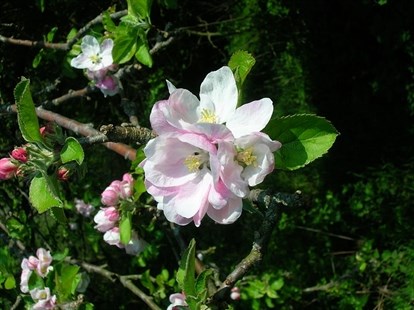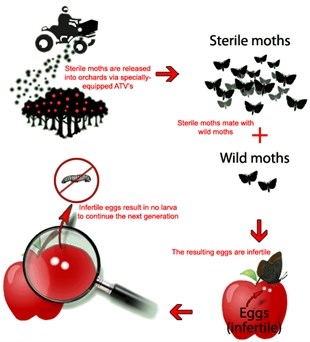
Image Credit: Wikipedia
April 29, 2013 - 12:16 PM
As the Okanagan's fruit trees begin to blossom, pest control officers will soon be checking their traps for codling moths. Officers will squish the moths, looking for the red dye that marks their sterile breed.
Since the introduction of Kelowna's area-wide pest management program, the once devastating insect is now sequestered to smaller areas of apple, crab apple and pear trees. But Sterile Insect Release board manager Cara Nelson says the program is as important as ever.
"The problem now is less than ten percent of our acreage has over 50 per cent of codling moth problem,” she says.
Kelowna city councillors will meet today to consider this year's program tax levies proposed by the Sterile Insect Release board. Each land owner in the Okanagan pays a small tax for the program and an additional parcel tax for owners of land 0.3 of an acre with at least 20 host trees. Nelson says orchardists currently pay about $139.26 per acre and that hasn't changed in the last four years.
But the program is getting harder to finance as the orchard industry shrinks.
“In Washington State it works quite well, but in our area where commercial orchards are interspersed with non-orchard properties it's more difficult,” Nelson says. The fixed costs of their rearing facility based in Osoyoos are spread over less and less property, creating a need for additional sources of revenue.
Sterile moths reared at the Osoyoos breeding facility are released every year into Okanagan orchards in time for the growing season. Sterile moths mate with wild moths, which prevents the hatching of larvae, or apple worms. Nelson says the interbreeding triggers a decline in the wild moth population.
Because the insect management is enforced area-wide, there are always some individuals who resist. Nelson says, “everyone has to do their part,” even if it means tearing down your fruit trees so the moth doesn't spread to commercial property.
In 2006 property owners in Creston Valley pressured their district to back out of the program. “It became quite a political issue,” says Nelson. Property owners didn't want people coming onto their property to monitor their trees.
“Now they're back up to five sprays,” she says.
The technology was introduced to the Okanagan back in 1990, when fruit growers decided they should reduce their use of chemical sprays. Nelson says there are still people who prefer to spray.
“It impacts our air and water quality, particularly in areas like Kelowna where you have so much rural and urban interface”
The good news is that as the wild populations have fallen people have to spray less.
“The levels we're at now are some of the lowest levels in the world for codling moth” Nelson says. For many orchadists today, one spray a year will suffice.
So long as land owners take care of their fruit trees Okanagan residents should be able to enjoy the fruits of their labor - before the moths do.

(OKANAGAN-KOOTENAY STERILE INSECT RELEASE PROGRAM / iNFOnews.ca)
To contact the reporter for this story, email Julie Whittet at jwhittet@infotelnews.ca or call (250)718-0428.
News from © iNFOnews, 2013